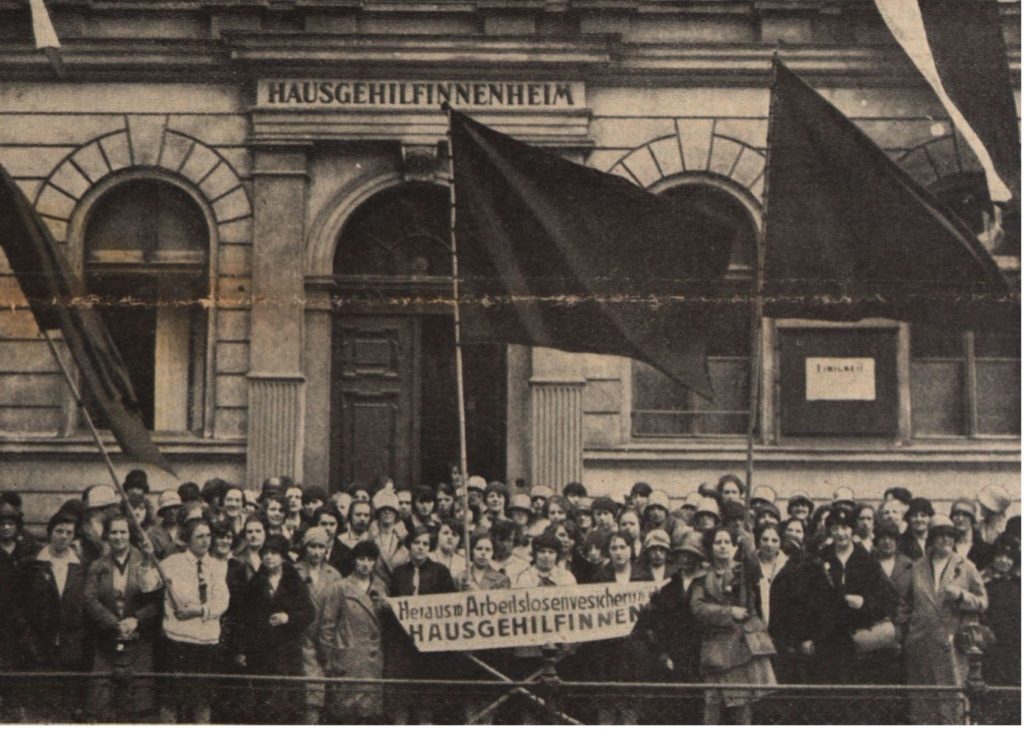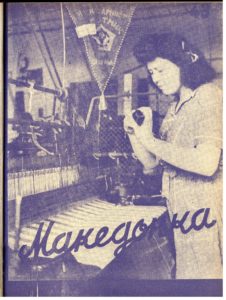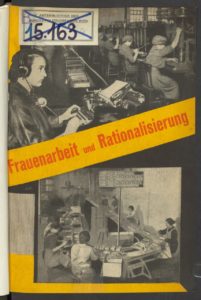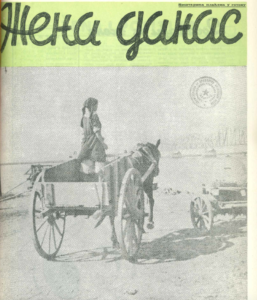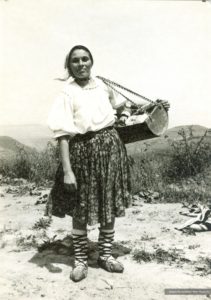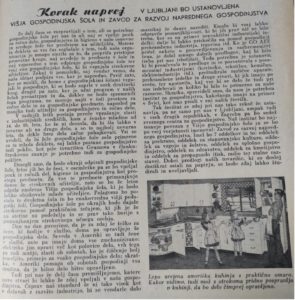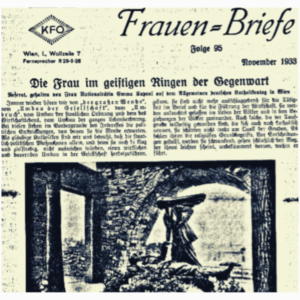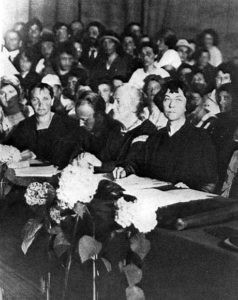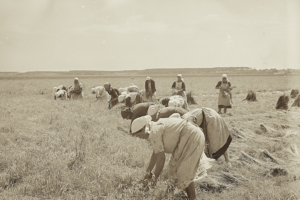by Jessica Richter
In the interwar period, two large interest organizations for domestic workers existed in Austria: The Social Democratic union Einigkeit [Unity] and the Catholic-conservative Reichsverband der christlichen Hausgehilfinnen [National Association of Christian Domestic Aides]. Despite all their differences, they had two things in common: both were committed to improving the working and living conditions of their clientele through interest politics and support and both were hardly able to ever mobilize more than ten percent of domestic workers in total even in Vienna. Against this backdrop, I examine what domestic workers did to improve their working and living conditions and what resources they could draw on.
At the turn of the 20th century, the “servant question” upset employers all over Europe. Loyal, hard-working “maids” seemed hard to come by. Seldomly they could rely on the few who still wanted to go into service at all, so employers claimed. Complaints about servants’ negligence and laziness, unfaithfulness, indulgence in gossip, and even thefts filled books and newspapers, were dealt with at enquêtes and parliaments.[1]
Discussions on allegedly unreliable servants were by no means new. But the fact that domestic service was changing could hardly be overlooked. In view of alternative employment opportunities, fewer women were willing to take up household posts on the one hand.[2] The decline was particularly noticeable in the 1880s when the number of so-called ‘domestic servants’ decreased by 41 percent from 775,882 to 456,277 persons in the western part of the Habsburg monarchy.[3] This continued in the First World War when women replaced men in all branches of the labour market. In 1919, only 66,481 live-in domestic workers were counted in Vienna opposed to 101,364 in 1910.[4]
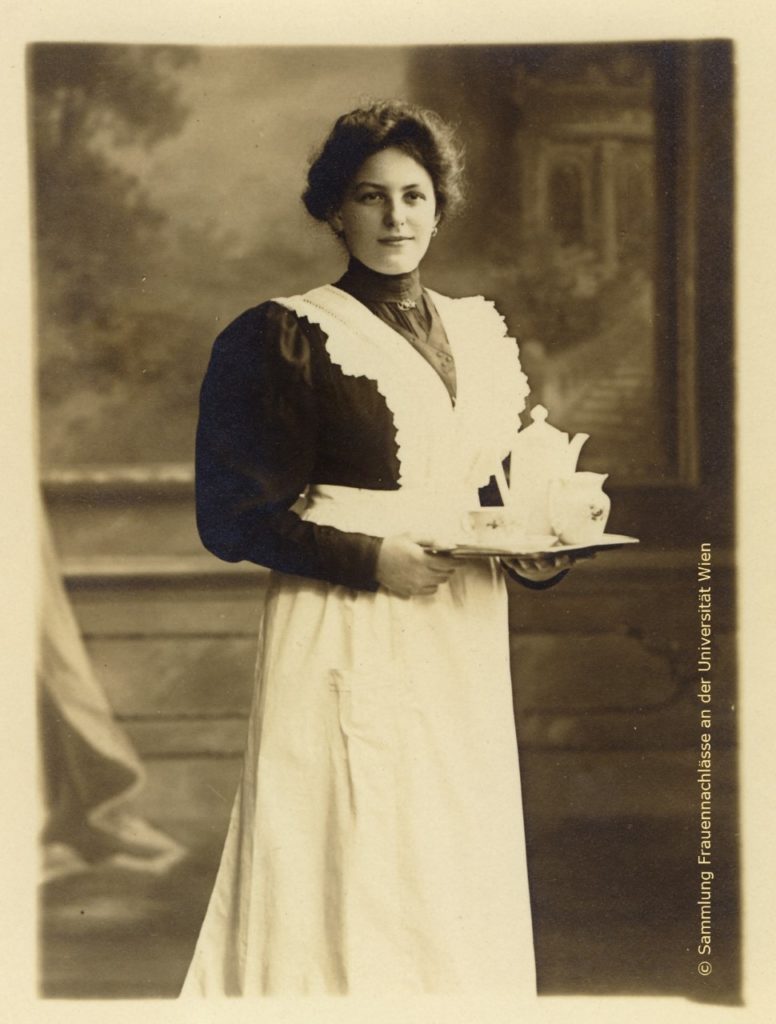
On the other hand, there was growing criticism of the service legislation in place, which was perceived as backward not only in liberal and socialist circles. Although it was a matter of earning a living, servants were legally not workers in the true sense of the word. As dependent members of the household who usually lived in the master’s house, they were obliged to obey and submit to the employers around the clock. In the preceding decades, domestic service developed almost exclusively into an occupation of poorer women from rural areas. Most of them migrated from other crown lands, often Bohemia or Moravia; some even from outside the Habsburg monarchy.[5]
A significant change in the legal situation was not forthcoming until the 1920s. Only the Hausgehilfengesetz [Domestic Aides’ Act] of 1920[6] established clear contractual standards and work-related rights, but these were hardly enforced in practice. In the absence of official control, employers for instance regularly exceeded permissible working hours.[7] In 1921, domestic workers were included in the workers’ health insurance scheme. However, they remained completely excluded from unemployment insurance as well as from accident insurance until the 1930s.[8]
In this period, posts in domestic service again became rare. Due to their relative impoverishment during the war, the number of employer households decreased by almost half to 52,493 households between 1910 and 1919 in Vienna alone. Recurring economic crises and high unemployment affected service as competition for available posts grew.[9] Hermine Kominek, born in 1907, had this experience when she sought a post in Vienna in 1924.
“In Vienna, bitter years of exploitation awaited me, unemployment and hardship were great. For example, 30 girls responded to an advertisement for a maid. You can imagine that you couldn’t make any claims. […] I worked at least 12 hours a day without a day off […].”[10]
Labour market access, moreover, was increasingly limited to Austrian citizens in the interwar years. This also affected many job seekers from Bohemia and Moravia who had been assigned Czechoslovakian citizenship after the war.
Both associations for domestic workers sought to shape this change in the interest of their clientele. The Catholic Reichsverband der christlichen Hausgehilfinnen, founded in 1909 on the initiative of the Catholic Workers’ Association and with the support of the Catholic Women’s Organisation, established branches in all federal states. The social democratic Einigkeit, founded two years after the catholic association, was focused mainly on Vienna.[11] In 1890, domestic workers joined the first May Day demonstration as well as meetings that organized social democratic women initiated for female workers. Social democratic activists around Adelheid Popp (1869-1939) took this as an opportunity to call assemblies for domestic workers in 1893/1894, where they demanded a fundamental change in the service legislation and social rights.[12]
Both organizations defined themselves as domestic workers’ representatives. The following statements are based on their member newspapers[13] and official reports. These of course can only provide the official image that the organizations created of themselves instead of insight into everyday activities and practices. However, they do allow an examination of the profound political differences that affected their agendas. From Einigkeit’s perspective, live-in domestic workers were particularly exploited and permanently exposed to their employers’ excessive demands. Their integration into the workers’ movement, therefore, seemed even more necessary. The functionaries aimed to transform domestic service into formalized and skilled labour, to bring about a separation of home and the workplace, and to ensure a decent income, continuity of work as well as social security.
Like Einigkeit also the Christian association agitated for contractually defined and legally secured rights, the improvement of working and living conditions, and the recognition of domestic service as an honorable vocation. Yet, in contrast to the social democratic union, its representatives linked this struggle with a policy of reconciling the interests of employers and their subordinates. The hierarchy between domestic workers and employers was not questioned and this also applied to the expectation of domestic workers’ loyalty. To support their clientele, both organizations offered legal counseling and vocational training. Placement and temporary accommodation for workers in search of positions became particularly important in the interwar years when due to a lack of alternatives an increasing number of women sought household employment. In 1934, Einigkeit was illegalized by the Austrofascist regime along with all other social-democratic organizations, which left the Catholic Reichsverband as the only major representative for domestic workers.
Despite the organizations constantly admonishing their clientele to organize, membership remained low and was characterized by high fluctuation as functionaries repeatedly criticized in their member newspapers. Einigkeit’s membership peaked at about 4,700 in 1928, but this was of little consequence in view of the total number of about 70,000 live-in domestic workers in Vienna at the time.[14] Moreover, the number of organized domestic workers varied greatly from year to year. The situation was equally tense for the Catholic Reichsverband: The peak of almost 5,300 members in 1920 was not reached again even after 1934.
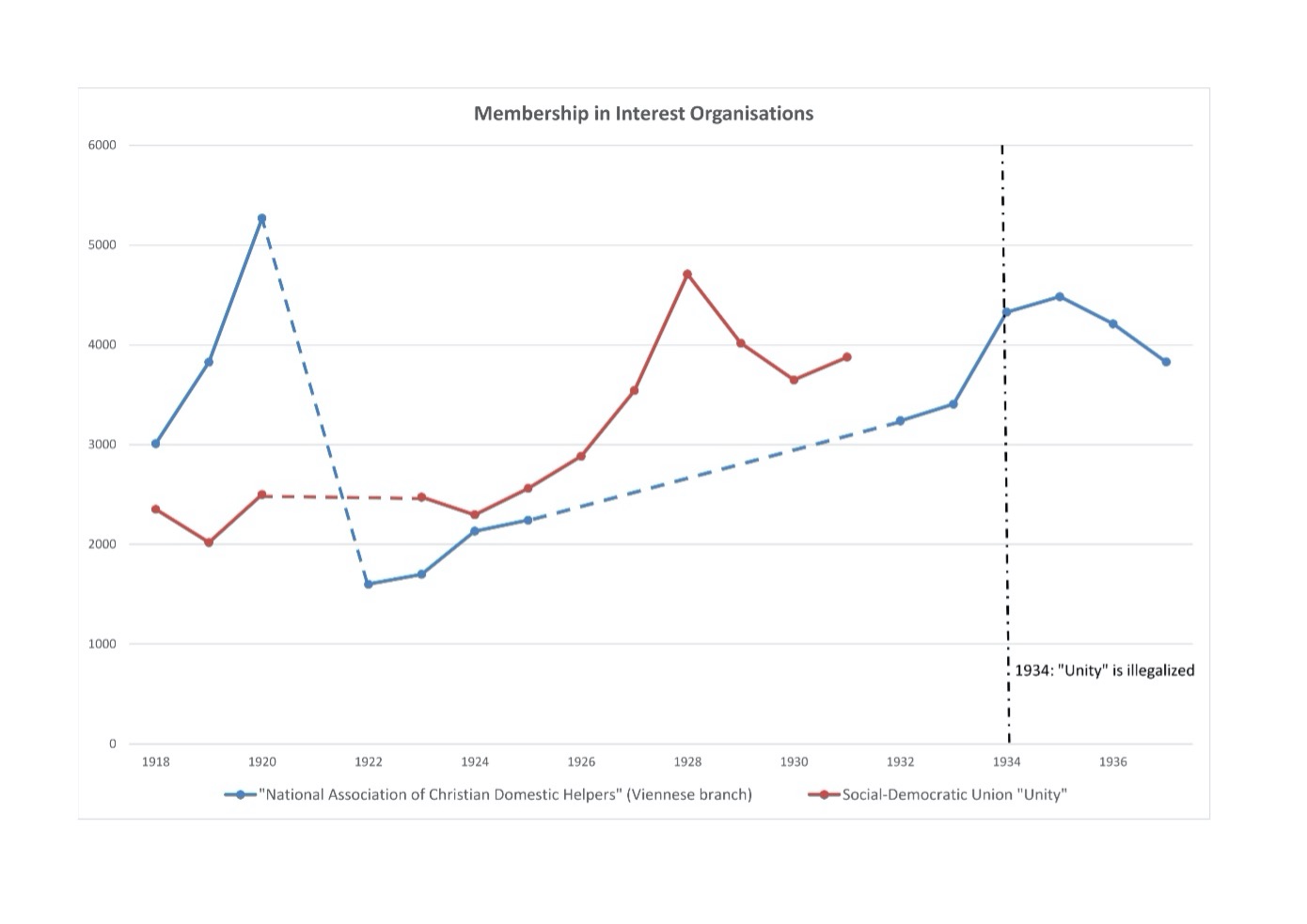
Rather than domestic workers’ long-term integration, the turnover of members indicates that they rather selectively used the organizations’ support. While some domestic workers took advantage of placement, shelters, training courses, or legal advice when needed, they mostly fought their struggles individually within the households. Employers generally disapproved of organized staff and live-in domestic workers were particularly at their mercy and at risk to lose their posts.
Domestic workers’ personal accounts, e.g. autobiographies or the few existing diaries, give insight into the wide variety of their practices – from fitting in, secretly undermining the unwritten laws of the household, by negotiating, or putting up a fight to change conditions in their favor. Households differed in many ways: in their composition and status, working conditions, equipment, and domestic workers’ relationships with the employers and their relatives, which were hierarchical in any case. Therefore, the strategies varied from worker to worker and from household to household.
If the conditions at a position were unbearable or better prospects opened up elsewhere, domestic workers often left the household after a short time. References to frequent changes of position can be found in the research literature as well as in the few existing contemporary surveys. According to a study by Käthe Leichter, head of the women’s department of the Vienna Chamber of Labour, only a good third of the domestic workers surveyed between 1924 and 1926 held the same position continuously.[15] An older survey from Graz suggests even more frequent changes. According to this, more than one fifth of the respondents remained in their posts for less than three weeks, and almost half for less than three months. Of the total of 586 domestic workers recorded, only 38 stayed with one employer for more than a year.[16]
A constant coming and going can also be found in domestic workers’ personal accounts. In many cases, they not only changed back and forth between different positions in domestic or agricultural service but also between services and other gainful employment. This was not always voluntary: in the tense economic situation of the interwar years, employment was often unstable and due to increased competition, employers found it easy to throw unloved domestics or staff too sick to work out on the street. Former live-in domestic workers often found themselves in precarious circumstances for they lost their accommodations along with their positions.
In some cases, however, the threat of leaving also helped to improve the situation, as Franziska K. found out in one of her many conflicts with her employer, a well-off elderly woman in Vienna.
“All right, I’ll go home. I don’t need [this position] that much”, so she told her. “In the morning, the sons […] gave me a good talking to and so I stayed, I was allowed to turn on my country music at 11 o’clock and I pushed through a few things that I thought were good.”[17]
However, Franziska K.’s victory did not last long. She quit after a visitor to the employer harassed her in her room at night, but the lady of the house refused to give her the key.[18] The Domestic Aides’ Act guaranteed domestic workers a lockable room – but there was little opportunity for workers to enforce these and other minimum standards.
When she left, her family came to her aid, and she could return to her parental home after losing her position. Similarly, Josefa Gastegger was accommodated and cared for by her mother after she lost her position due to a prolonged illness, as can be learned from her diary.[19] The parental home proved to be a resource for many, as they could rely on support in times of need. Relatives, conversely, continued to draw on the labour of domestic workers for many years after they had entered service for the first time – by demanding remittances to support the household income or by requesting their return to help out in the house or at the small farm when additional hands were needed.
The importance of family support is highlighted by cases of those domestic workers who grew up without parents. Johanna Konrad, born in 1910, was one of them and she had to take care of her child on top of everything else. Often, the only option was foster care. A few farmers she worked for gave permission to bring her daughter but then she had to accept deductions from her wages.
“As it was at that time, I always had to look for something new. […] I took on any job so as not to be unemployed.”[20]
She and many others had to accept rather poor conditions in service to make a living.
References:
[1] Cf. e.g. Ebl., “Dienstboten-Misere” [Servant Misery],“ Wiener Moden- und Hauswesen-Zeitung, October 10, 1881, 3; Katharina Migerka, “Die Dienstmädchenfrage in einer anderen Beleuchtung [The Servant Question from a Different Point of View],” Dokumente der Frauen 2, no. 21, January 15, 1900, 573-580, here 573f.; Regine Ulmann, “Wieder die ‘Dienstbotenfrage’ [The ‚Servant Question‘ Again],“ Das Blatt der Hausfrau VII, no. 19, 1896/1897, 3f. See also Raffaella Sarti, “Conclusion. Domestic Service and European Identity,” in The Modelization of Domestic Service/La modélisation du service domestique, ed. By Suzy Pasleau and Isabelle Schopp with Raffaella Sarti (Liège 2005), 195-284, here 248f. For the quote in the title cf. Hermine Kominek, born 1907, Meine Lebensgeschichte [My Life story] (Dokumentation lebensgeschichtlicher Aufzeichnungen/Collection of Biographical Records, manuscript 1985).
[2] Heidi Müller, Dienstbare Geister. Leben und Arbeitswelt städtischer Dienstboten [Subservient Spirits. Urban Servants‘ Life and Work] (Berlin 1985), 24f.; Uta Ottmüller, Die Dienstbotenfrage. Zur doppelten Ausnutzung von Dienstmädchen im deutschen Kaiserreich [The Servant Question. On the Double Exploitation of Servants in the German Empire] (Münster 1978) 42f., 52.
[3] Hannes Stekl, „Soziale Sicherheit für Hausgehilfen,“ in Soziale Sicherheit im Nachziehverfahren. Die Einbeziehung der Bauern, Landarbeiter, Gewerbetreibenden und Hausgehilfen in das System der österreichischen Sozialversicherung [Delayed Social Security. The Inclusion of Farmers, Agricultural Workers, Trades(wo)men and Domestic Workers in the Austrian Social Insurance System], ed. by Ernst Bruckmüller, Roman Sandgruber and Hannes Stekl (Salzburg 1978), 174-224, here 193f.
[4] Einigkeit, Der Aufstieg der Hausgehilfinnen und Hausarbeiterinnen. Bericht der „Einigkeit“ 1924-1928 an den Verbandstag der Hausgehilfinnen, Erzieherinnen und Hausarbeiterinnen Oesterreichs am 24. November in Wien [The Rise of the Domestic Workers. Report of the “Einigkeit” 1924-1928 to the Association Congress of Domestic Workers, Educators and Home Workers of Austria on 24 November in Vienna] (Vienna 1929), 34.
[5] Sylvia Hahn, Frauenarbeit. Vom ausgehenden 18. bis zum 20. Jahrhundert [Women’s Work. From late 18th tot he 20th Century] (Vienna 1993), 28; Fritz Winter, “Statistisches [Statistics],” Dokumente der Frauen 2, 15 January 1900, 584-589, here 585.
[6] „Gesetz vom 26. Februar 1920 über den Dienstvertrag der Hausgehilfen (Hausgehilfengesetz) [Law of 26 February 1920 on the Servive Contract of Domestic Aides (Domestic Aides Act)],“ StGBl. 1920, no. 101.
[7] Käthe Leichter, „Eine Erhebung über die Lebensverhältnisse der Hausgehilfinnen [A Survey on the Living Conditions of Domestic Workers],“ Arbeit und Wirtschaft IV, no. 18, September 15, 1926, 737-740.
[8] Stekl, „Soziale Sicherheit“, 210, 215; „Bundesgesetz, betreffend die gewerbliche Sozialversicherung (GSVG) [Federal Law Concerning Commercial Social Insurance],“ BGBl. 1935, No. 107, §§ 142, 176 (1).
[9] Einigkeit, Aufstieg, 34.
[10] Kominek, Lebensgeschichte.
[11] I dealt with the associations in detail in my dissertation. Cf. Jessica Richter, „Die Produktion besonderer Arbeitskräfte. Auseinandersetzungen um den häuslichen Dienst in Österreich (Ende des 19. Jahrhunderts bis 1938) [The Production of a Special Workforce. Struggles over Domestic Service in Austria (Late 19th Century to 1938)],“ (Diss., University of Vienna, 2017), 74-98
[12] Einigkeit, Aufstieg, 7f.
[13] The member newspaper produced by the Catholic “Reichsverband”, “Die Hausgehilfin” [Domestic Aide], was published from 1919. The “Einigkeit”’s paper, however, repeatedly changed its name to reflect organizational changes in the association. News of “Einigkeit” appeared in the newspaper “Einigkeit” (from 1911), the “Vereinsblatt [Association Paper]” (from 1913), again in “Einigkeit” (from 1924) and in “Die Hausangestellte” [Domestic Worker] (from 1928).
[14] Einigkeit, Aufstieg, 22f.
[15] Leichter, „Erhebung,“ 739.
[16] Karl Schwechler, Die Städtischen Hausdienstboten in Graz. Beiträge zur Dienstboten-Statistik [The Urban Housemaids in Graz. Contributions to Statistics on Domestic Servants] (Graz 1903), 25.
[17] Franziska K., No title (Dokumentation lebensgeschichtlicher Aufzeichnungen, manuscript 1983-1984), 57.
[18] Ibidem, 59.
[19] Josefa Gastegger (maiden name: Donabaum), Sammlung Frauennachlässe, NL 47, diary 1921-1926, entry of February 25, 1923.
[20] Johanna Konrad, Die Lebensgeschichte einer Frau [Life Story of a Woman] (Dokumentation lebensgeschichtlicher Aufzeichnungen/Collection of Biographical Records, manuscript 1989), 19.
Illustrations:
- Organized domestic workers demand inclusion in unemployment insurance on 1 May 1929. In the background: one of the two municipal homes for domestic workers that were run by the Social Democratic union “Einigkeit”. Source: Die Hausangestellte. Organ des Verbandes der Hausgehilfinnen, Erzieherinnen, Heim- und Hausarbeiterinnen‚ Einigkeit’ Oesterreichs, 17, no. 5, (Mai 1, 1929), 1.
- A domestic worker Martha Teichmann (1888–1977). She migrated from Dresden to the USA in 1909 to overcome a failed love affair. Domestic workers gave a large variety of reasons for their frequent changes of position and their constant mobility. From their perspective, however, this was also the only way to leave behind unbearable working and living conditions and conflicts with their employers. Source: Sammlung Frauennachlässe, NL 67: Martha Teichmann, geb. 1888.
- The figure shows how membership developed in both interest organizations in the interwar period. Dotted lines: No data was available. Author: J.R. The membership figures presented in the graph were taken from different publications.
Jessica Richter studied Social Sciences and European Regional Development in Hanover and Cardiff. In Vienna, she wrote her dissertation on the social struggles over domestic service in Austria (ca. 1880 to 1938). She is currently leading a research project on the organization of rural labour at the Institute for Rural History in St. Pölten.

